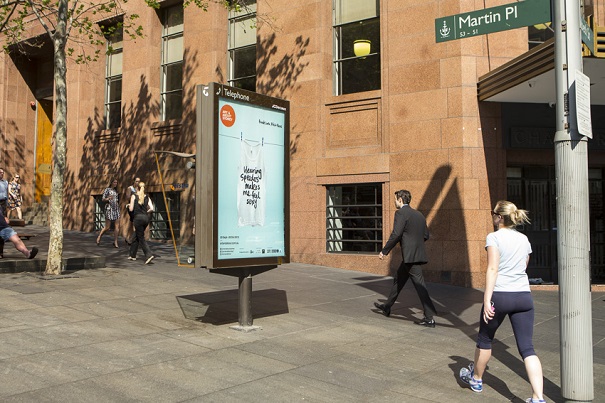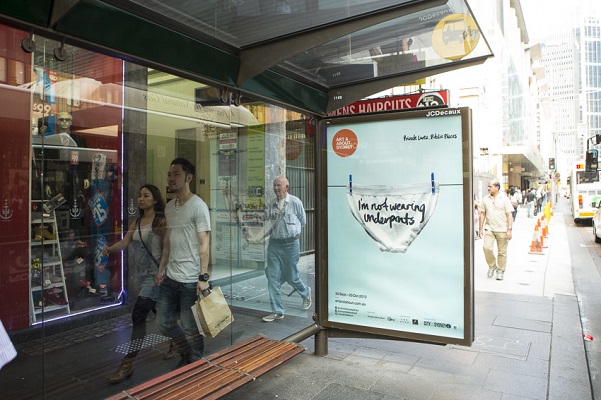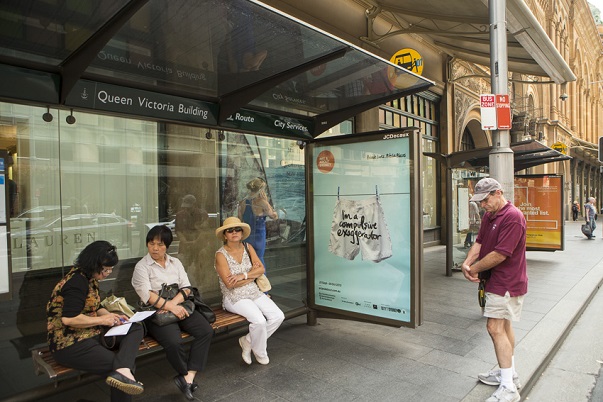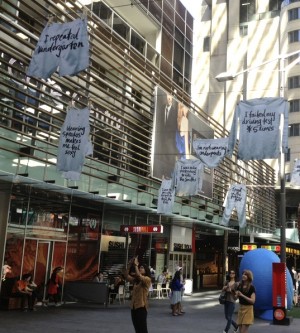Artist of the Week 10/16-10/22: Alphabet Studio Airs Out Sydney’s Dirty Little Secrets
Who knew that airing out one’s dirty laundry could be such fun (of course, by dirty laundry, we mean secrets)!
Walking around Sydney’s central business district (CBD) and its surrounding areas, you might find yourself, quite unexpectedly, encountering intimate confessions written on white undergarments and apparel, such as “I like the texture of bald heads,” “odd numbers make me feel queasy,” or “I feel nervous around cats.” Part of the Art & About festival in Sydney, Australia, 22 secrets have been revealed to the public (albeit without the names of the participants) by way of posters on city streets and bus stops as well as overhead clothing lines, in a project entitled City Lights. Self-described as “revealing, raw and honest” by Ashleigh Steel, a member of Alphabet Studio (the design group behind the project), the interactive exhibit is a humorous look into the quirks and daily lives of everyday people.
According to Steel, the witty tone behind the showcase was intentional, not only to stand-out amongst other secret-based projects, but to also emphasize the importance of accepting oneself and others – an important message in today’s, often deemed, “bully society.” Known for their visual communication endeavors, the Sydney-based Alphabet Studio has created a piece that will move even the most cynical of souls, due to its reverberating and relatable nature. After all, who doesn’t have a dirty little secret?
Hoping for continuous growth and an international audience, Steel took the time to speak to GALO about the meaning of the piece, how they gathered the juicy confessions, and whether or not we can find their own secrets hanging above the city lights.

A piece from the project City Lights, with the secret “Wearing speedos makes me feel sexy,” is displayed on the streets of Sydney. Photo Courtesy of: Alphabet Studio.
GALO: Your City Lights project reminds me a bit of the song “Dirty Little Secret” by the All-American Rejects as well as the book and Web site PostSecret, created by Frank Warren, where people mail in their secrets on a postcard anonymously to be published online. However, your project differs a bit by showcasing the secrets on white clothing and hanging it up for the public to see. Where did your inspiration for this project come from — is it a metaphor for airing out one’s dirty laundry? And what do you hope that this public art exhibition will accomplish in terms of viewer interactivity as well as those who are revealing their innermost mysteries (are you hoping people accept that part of themselves — come to terms with their desires or inner demons — or are the messages there to serve as eye openers for others)?
Ashleigh Steel: Our starting point for the project was to interpret the Art & About 2013 theme “Private Lives…Public Places” in a clever, witty and humorous way. We drew our main inspiration from the blurred line between public and private, which are of particular relevance in our current social media-dominated climate. People seem eager to tell-all in an online sphere, where they can alter and construct a version of their true selves, editing out the “imperfect” parts. Essentially, in private we can be anything we like, but what happens when we hang ourselves out to dry for the world to see? Do we all share the same common quirks, secrets and thoughts? Could recognizing and “airing” these idiosyncrasies bring us closer together? We wanted to strip it all back and find out what lies beneath our manicured exteriors, in an attempt to stimulate conversation. The tone of lightness and humor is essential to the project, as it aims to celebrate these idiosyncrasies and encourage people to accept their own hidden desires or inner demons.

A piece from the project City Lights, with the secret “I’m not wearing underpants,” is displayed at a Sydney bus stop. Photo Courtesy of: Alphabet Studio.
GALO: Why did you decide on using clothing as your material of choice and why did you pick monochromatic colors, instead of using variations of different shades such as light blue, yellow and pink, which in turn could draw more attention to themselves than just via the messages?
AS: The use of clothing in this project is a very literal interpretation of the common phrase “airing one’s dirty laundry,” and creates a highly personal canvas on which to “hang” the secrets. The use of only white clothing was intentional to create the sense of the “every man”; that these secrets and thoughts did not belong to one individual, with a particular taste in clothing, but rather to everyone. We needed the canvas for the secrets to be really stripped back, to allow the message to be the hero.

A piece from the project City Lights, with the secret “I’m a compulsive exaggerator,” is displayed at a Sydney bus stop. Photo Courtesy of: Alphabet Studio.
GALO: Did you yourselves write and hang any of your own secrets?
AS: Yes, we did write and hang a few of our own secrets. But we actually found it easier to use the secrets and quirks of our family and friends! I suppose they seemed more interesting and amusing to us, as revealing our own confessions made us feel a little vulnerable at the beginning of the project. Upon reflection, this really speaks to the core of the project — that most of us really are reluctant to “reveal all” and that we harbor a certain amount of shame in exposing our habits and quirks. To some extent I think this project asks us why that is.
(Interview continued on next page)

